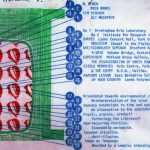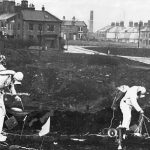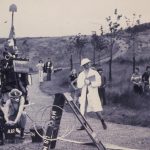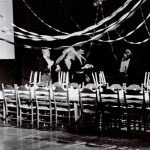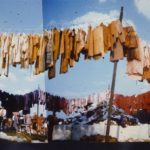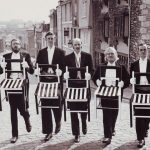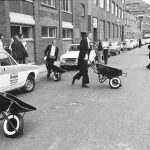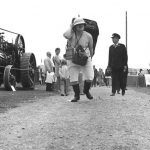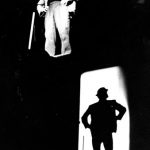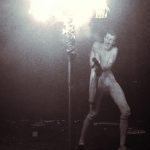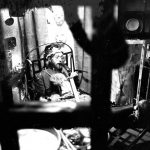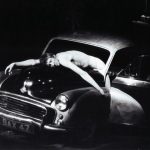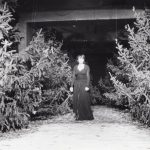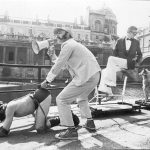Company Name: John Bull Puncture Repair Kit
Founders: Mick Banks and Al Beach
Established: 1969
Reason: Mick Banks and Al Beach’s interest in sculpture and installations had moved into performance ideas. After settling in the Halifax area, their involvement with ‘alternative theatre’ practitioners Albert Hunt, John Fox and Jeff Nuttall led to them to setting up their own company – Jeff Nuttall coined the name ‘John Bull Puncture Repair Kit’.
Current Status: John Bull Puncture Repair Kit ceased performing in 1976 partially as a result of the pressures from being a touring company and partly because ‘…. the formula couldn’t last much longer’ (Mick Banks, Unfinished Histories interview 2014). Founder member, Mick Banks and his partner Corinne D’Cruz formed British Events, a theatre company that is still operating and is based in Dover.
Area of Work: Experimental, Performance Art and Street Theatre
Policy: An early publicity leaflet lays out a number of ideas that interested the company: ‘Image as language …. Moulded by a complex interplay of choice and chance …. Anti-illusion …. Orientated towards environmental circumstances …. An alternative to the spectator role’ (ref. John Bull Puncture Repair Kit publicity leaflet c.1971)
As their work developed, the importance of humour to create an interface with the public also became a defining feature. They distanced themselves from ‘theatre’ as they felt that theatre in Britain was stagnating.
Outdoor performance events that attracted large crowds, such as arts festivals were ideally suited to their particular mayhem and these were far less restrictive environments than galleries or theatres. Outdoor work was complemented by indoor performances at venues such as Arts Labs, which were receptive to their kind of experimental work.
Structure: For five years Mick Banks and Al Beach were at the core of John Bull Puncture Repair Kit activities. Initially the JBPRK ‘brand’ emerged in a creative climate in which artistic collaboration was seen as aesthetically and ideological important. This was encouraged by the Arts Council through (modest) bursaries to ‘individual artists’ rather than to ‘groups’. The appetite for collaborative work in Yorkshire at the time was also the shaped by the extraordinary gathering of creative artists that were living and working in the area.
By 1972 John Bull Puncture Repair Kit had established itself as a five man company with Mick Banks and Al Beach being joined by John Darling, Des ‘Diz’ Willis and George O’Brien. As well as the individual specialisms they brought to the group, all five performed. ‘Everything was improvised and anyone could take the initiative – there was no theatrical hierarchy….. it worked because they were all like-minded – they all came from an art school background’ (Mick Banks, 2014)
In the early days Mick Banks did the administration from his home – later Al Beach took over this role. Props and assemblages were stored in cheap rented accommodation that was readily available in the Halifax area. They didn’t need rehearsal space because their work mainly evolved out of discussion and scripts weren’t written down beyond the essential planning and structuring of soundtracks. There was little change to the company until 1975. John Darling was occasionally absent due to teaching and family commitments and ‘guest’ performers would often join in. Diana Davies and Geraldine Pilgrim took important female roles in performances.
Based: John Bull Puncture Repair Kit was a Yorkshire based company that toured extensively throughout the United Kingdom, Holland, Northern Germany and Denmark.
Funding: Initially they were subsidised by the Arts Council in the form of individual visual artist’s bursaries and later they were revenue funded. Commissioned work for festivals in Holland, Germany and Denmark were also financially important to the company.
Performance venues:
Indoor venues included – UK: Bingley College, Birmingham Arts Lab, Chapter Arts Centre Cardiff, Cumbernauld Cottage Theatre, Everyman Theatre Liverpool, ICA Theatre, Jeanetta Cochrane Theatre, King’s Head Theatre, Manchester University Theatre, New Arts Lab, Newcastle University Theatre, Norwich Arts Centre, Nottingham Playhouse, Oval House, Phoenix Theatre Leicester, Plymouth Arts Centre, Pool Theatre Edinburgh, Sheffield Studio Theatre, Stirling University, Third Eye Centre Glasgow, York Arts Centre, Walcot Village Hall, Bath. Abroad: Melkweg Amsterdam, Paradiso Club Amsterdam, De Lantaren Rotterdam, Gallerie Hammer Berlin, Aarhus Theater Denmark
Outdoor locations included – UK: Bath and West Show Shepton Mallet, Bickershaw Rock Festival Wigan, Birmingham, Blackpool Airport, Bradford, Chesterfield, Coventry, Derby, Doncaster, Edinburgh, Exeter, Falmouth, Halifax, Harrogate, Hebden Bridge, Huddersfield, Leeds, Leicester, Liverpool, Manchester, Middlesbrough, Milton Keynes, Newcastle-upon-Tyne, Plymouth, Redcar, Royal Agricultural Show Warwickshire, Serpentine Gallery London, Southampton, Stoneleigh Festival, Swansea, Swinton & Pendlebury Festival, Warrington, Wigan, Whitworth Festival, Wolverhampton Polytechnic, York, Walcot Festival Bath. Abroad: Germany (Braunschweig Berlin, Bremen,Bonn, Munich) Holland ( Rotterdam, Tilburg, Eidhoven,Nijmegen, Leewarden, Gronigen, Utrecht, Arnhem) Norway (Henie Onstad Kunstsenter, Oslo, Sonja Henie Centre) Denmark (Aarhus)
Audiences: The company’s emphasis on outdoor performance, especially within Northern industrial communities, led to them effectively broadening the social mix for experimental work. Later they extended their reach by performing at traditionally conservative venues such as Agricultural Shows. The subversive nature of their work was made more acceptable by the use of visual humour that appealed to a variety of age groups and social classes. Their indoor performances were more experimental and darker – suited to the ‘alternative’ or underground scene.
Company work and process: In 1969 Mick Banks and Al Beach were working together as visual artists in the Ryburn Valley area, near Halifax. Early examples of their ‘live art’ , such as Edible Memories and Black Ice-Cream, explored the idea of paradox. ‘There was an energy in Yorkshire at the time, partly in response to the cultural vacuum that existed in this industrial area’ (Mick Banks, Unfinished Histories interview 2014). The proximity of Bradford School of Art, Leeds Polytechnic and Bradford University (the ‘Yorkshire Vortex’) brought them in contact with Albert Hunt, John Fox and Jeff Nuttall – all associated with ‘the world of happenings and events’ (Mick Banks, e-mail correspondence with Unfinished Histories 2015). Their first performance piece as John Bull Puncture Repair Kit was with Jeff Nuttall at the Birmingham Arts Lab in Autumn 1969. Nuttall was booked for a poetry reading and the John Bull Puncture Repair Kit performance was added to the bill. In addition to being employed on various educational projects, Mick Banks and Al Beach secured funding from the Arts Council’s New Activities Committee to start an Arts Lab in Halifax – Northern Open Workshops (N.O.W.) and they organised the A-Wake Festival at Hebden Bridge – a ‘gathering’ that brought together groups such as The People Show and Welfare State. Throughout 1970 they worked on a variety of projects in various media. For JBPRK performances they were sometimes joined by Tim Stocker, the manager of N.O.W. and the poet, Ulli McCarthy. There was a London appearance at the New Arts Lab that year and early in 1971 one at Oval House.
‘We started from the basic premise that you could use image instead of language’ (Mick Banks, 2014). They were inspired by the ‘…. post-industrial landscape of empty factories, run-down buildings, huge quantities of machinery… on great scrap piles everywhere’. The starting point for their early work was often a piece of machinery – a found object – or an assemblage that resonated with a specific environment. Earth Probes from 1971, was an outdoor piece that drew inspiration from the recent moon landings. The newly established tropes of space exploration were played out in the deserted post-industrial landscape of Bradford to the accompaniment of amplified breathing and crackly intercom communication. The group’s Bedford van was their space capsule – Mick Banks and Al Beach in spacesuits, emerged onto a piece of derelict land, ‘collecting samples’ and carrying out ‘tests’.
Edinburgh 1971
In 1971 John Bull Puncture Repair Kit were invited by Chris Barr, of Bradford University, to create an indoor piece for The Pool Lunchtime Theatre Club at the Edinburgh Festival. As all their previous work had been improvised, Mick Banks and Al Beach invited John Darling to help them ‘choreograph’ this indoor performance. John Darling was a lecturer in sound – working with Jeff Nuttall in the Fine Art Department of Leeds Polytechnic. He had been an early member of The People Show for whom he created taped soundtracks – as well as performing. Applying the same approach to JBPRK, John Darling’s soundtrack provided a structure that allowed them to improvise but gave their work an underlying shape. The piece Four-Dimensional Condition, became a surprise cult hit of the Festival and the use of the soundtrack set the pattern for most of their later indoor pieces.
Whilst at the Edinburgh Festival they also staged Conceptual Morris Dancing in Princes Street Gardens and Climbing Arthur’s Seat which characteristically used highly coloured ‘props’ as the starting point – a number of tall yellow, red and blue flags that had been made by John Darling with no prior idea as to how they would be used. This process of ‘taking visual ideas and putting them in the real world’ was just one example of what Mick Banks and John Darling came to refer to as ‘performance art’ – an early use of the term (1971). A key aspect of their work was ‘…the use of colour and monochrome work [that] became a unifying feature in a lot of John Bull Puncture Repair Kit work’ (Mick Banks, 2014). Even a late theatre piece, The Black and Red Club (1976) used extraordinary colour coding – including the food and drink served at the club – that harked back to the earlier ‘black ice-cream’ project.
Going full-time 1972
The success of the Edinburgh shows led Mick Banks and Al Beach to make JBPRK a full-time job helped by the artist’s bursaries they were awarded by the Arts Council. John Darling retained his teaching job throughout his four year involvement with the company. At the Norwich Arts Lab they had met Des ‘Diz’ Wilson. Diz was a poet and another collaborator with Jeff Nuttall. He started to ‘guest’ with JBPRK and from 1972 became a full-time company member. He was ‘brilliant at making things’. Around the same time George O’Brien, a dancer from Moving Being joined the company. He brought ‘a professional performance element to the mix’ (Mick Banks, 2014). This completed a line-up that was to run for the next three years. They were five like-minded visual artists that worked together very comfortably. The company was non-hierarchical and anyone could take the initiative on performances.
Guesting
Just as Mick Banks had ‘guested’ with other companies – such as with Shirley Cameron and Roland Miller on the Cyclamen Cyclists project (1971) – so, guest performers would regularly join them. Film Crew was particularly adaptable to changes of personnel – useful when John Darling’s teaching and family commitments kept him away. The dancer, Diana Davies, performed with them in Rotterdam in Absent Friends and was also sometimes part of the Film Crew. Geraldine Pilgrim had been in The Clothes Show and joined them for a Denmark tour in 1975.
Festivals, outdoors and indoors
Festivals were an obvious context for their outdoor work. They had effectively learned to engage the public through humour ‘ … that’s one of the big traits that runs through a lot of John Bull work both outside and inside – it’s this ability to negotiate your way over the vast cathedral silences of [later gallery-based] performance art with humour and that set us apart’ (Mick Banks, 2014). There was demand for the work of JBPRK and they were sought out by festival organisers. Fire-Appliances came out of an idea to build a fire engine out of scrap materials. Pyrotechnics featured in many of their outdoor events – as they had a useful contact at Standard Fireworks. The basic scenario of Fire Appliances was that they ‘created their own pyrotechnic disasters and then dealt with them’ (Mick Banks, 2014). At Bickershaw Rock Festival they had buried a dummy WW2 bomb underneath the festival site prior to the opening and over the couple of days of the festival the fire appliance crew dug it up and ‘defused’ it.
The anarchic spirit of the group could have comparatively free reign in outdoor settings whereas indoor settings could be restrictive – for example a British Council event in a smart Berlin theatre foyer led to them being moved to a gallery after one day as they were too messy.
JBPRK often presented themselves in evening tailcoats with white ties – their short hair and dapper appearance wrong-footed the conservative elements that they inevitably encountered through widening the constituency of their outdoor work. As well as subverting ‘establishment types’ the harsh ‘black-and-whiteness’ of the formal wear was a simple way of creating a striking visual effect – enhanced further in Morbid Interests as the five performers carried black and white striped chairs. In Gunman, evening tailcoats were stripped off to reveal the company to be wearing red wrestling tights beneath.
The pressure to generate large quantities of original material led to a strategy where familiar elements could be adapted to the opportunities and limitations of a specific environment. Fire Appliances, Street Artists and Film Crew were all such examples. Film Crew was built around the premise that a film crew are on location shooting a film, The Trial. The stock characters – cameraman, stuntman, the star, etc. could be adapted to specific circumstances as various mishaps and pyrotechnic disasters intervened.
Large scale installations
At the suggestion of Roland Miller they broadened their audience further on two occasions by creating large scale installations at agricultural shows. Colour Wheel centred on the construction of a huge wheel that would support a large number of jumble-sale clothes. Over the few days of the show the clothes were sorted and suspended on coat hangers – grouped according to the colour spectrum and raised on the wheel. The Colonial Bungalow at the Bath and West Show also involved an ambitious construction project taking place over a number of days. On completion the company staged mock ‘heroic’ scenes from the British Empire.
Outdoor events were often played alongside the more structured and careful planned indoor ‘theatre’ pieces. On occasions the two aspects of their work were merged. In Morbid Interests after the first two acts had been performed in the Plymouth Arts Centre theatre space the audience were then led out into the streets and finally to the shore – where they were invited to stand on chairs and throw money into the sea (Mick Banks, 2015).
Working abroad
Along with The People Show and The Phantom Captain – John Bull Puncture Repair Kit’s work found enthusiastic audiences abroad – especially in Holland, Germany and Denmark. The anarchic humour and the primacy of the image made their work very accessible. Funding for risk-taking theatre was more generous than in the UK – enabling the company to be more ambitious with indoor productions and to work in well-equipped theatres such as De Lantaren, Rotterdam. The Crime Show utilised the ability to ‘fly’ objects into the performance space and the show incorporated an actual horse and a sports car that was driven into a set built apparently from concrete pillars. Absent Friends and The Black Hole Show both used tightly focused and precisely cued lighting effects and The Black Hole Show also utilised the ultra violet effects that the company had experimented with in Amsterdam’s Melkweg and Paradiso clubs. As shows became more complex the company toured with their own technicians. Southern Comfort opened with a ten minute Son et Lumiere sequence using a large bank of sand – seeds fall onto the virgin earth. ‘It rains real rain. Flowers emerge from beneath the sand. A hole slowly forms in the sand dune. Adam and Eve appear from within. Half the stage is Eden. The other half is a scrap yard owned by the Devil. Geoff Amos and Tim Seely were the two technicians we took on that tour to operate lights, sound and flying effects’ (Mick Banks, 2015)
Final years
In 1975 Ted Little, from the Birmingham Arts Laboratory, had moved to the ICA and commissioned them to produce an installation. The Stately Home was inspired by the external appearance of the ICA and used a labyrinthine structure that was like a parody of a stately home tour – peopled by JBPRK and guest performers. Over the five day run ‘….it got darker and darker. The rooms got smaller as you moved back towards a dungeon where Diz got electrocuted on an electric chair everyday. It got a bit out of control … [and] …was not a happy time for John Bull’ (Mick Banks, 2014). The Stately Home marked the beginning of the end for the company. ‘Al Beach had had mental health problems since he was a teenager and at this point the JBPRK environment – drugs, pressures of touring, inter-personal tensions within the group – wasn’t a good one for him to be in and he was hospitalised’ (Mick Banks, 2014). In addition to these personal difficulties there was an underlining feeling that ‘…. the formula couldn’t last much longer’ (Mick Banks, 2014). In 1976 Diz Willis left the company to return to higher education as a mature student and George O’Brien pursued his interest in fine art. Geraldine Pilgrim joined John Darling and Mick Banks on a successful Danish tour and the show they created for Aarhus in Denmark The Black and Red Club was described by Mick Banks as ‘one of their most subtle shows’. John Darling would go on to work with Geraldine Pilgrim in her company Hesitate and Demonstrate. Al Beach’s health recovered and he formed his own theatre company Le Blonde. Mick Banks and Corinne D’Cruz [ex- Natural Theatre and festival organiser] worked in Australia, and upon returning set up their own company British Events – based in the UK till 1988 and then in Germany till the end of 2012 when they moved to Dover.
Reviews:
‘Recalling that their programme had spoken of the interplay between choice and chance, my heart sank. But then things began to happen. There were music, rhythms, electronic shrieks. A parrot, boxes, string. I was terrified because after a while I had no idea what might happen next; they worked up to a frenzy of inconsequence and then sobbed together to the strains of “Ave Maria”. This was not a play but an event. Wild, grotesque, hilarious.’ The Scotsman September 1971
‘John Bull’s outdoor work was extraordinary – it was a mixture of music hall and surrealism and, in my opinion, they were THE performance company of the late 1960’s (sic)’ Brian Popay Street Arts: a User’s Guide London, 2003
‘Their work is of a very strong visual nature with a concern for moving images relating to a central idea. This manifests itself through objects of surprising colours, used in extraordinary ways and placed in unusual juxtapositions. Their structure is alogical and because of this the spectator can no longer be considered a voyeur, but react to it in a positive way’ undated quotation from The Guardian on JBPRK publicity, 1973
Production Table:
| PRODUCTION NAME | VENUES | DATES |
|---|---|---|
| John Bull Puncture Repair Kit Devised and performed by the company - including Mick Banks, Al Beach and Jeff Nuttall | Birmingham Arts Lab | Autumn 1969 (probably about October 1969 ref. Mick Banks, 2015) |
| And The Crypt Indoor performance Devised and performed by the company - including Mick Banks, Al Beach, Tim Stoker and Ulli McCarthy | Northern Open Workshop, Halifax | 1970 |
| John Bull Puncture Repair Kit Event at the Meristem Festival Devised and performed by the company - including Ulli McCarthy, Tim Stoker, Mick Banks and Al Beach | Meristem Festival, Norwich Arts Lab | 27th -28th February 1970 (festival dates) |
| The Assassination of Enoch Powell Indoor performance Devised and performed by the company - including Mick Banks, Al Beach, Tim Stoker and Ulli McCarthy | Northern Open Workshop, Halifax | 1970 |
| Landscape (aka Terminal Landscape) Trevor Wishart & Al Beach, Michael Banks (featuring airborne musical instruments, hilltop vocalising, military fireworks and black ice cream) | A-Wake Festival, Hebden Bridge, Yorkshire | 1970 |
| Angles Outdoor event Devised and performed by the company - including Mick Banks and Al Beach | Bradford Festival, York Arts Festival and Festival in Braunschweig, North Germany | 1970 |
| Up Your Country Indoor performance Devised and performed by the company - including Mick Banks, Tim Stocker and Al Beach | Leeds Polytechnic | 1970 |
| Shapes Indoor performance Devised and performed by the company | Lyons Concert Hall, York University | 1970 |
| Art /Technology Seminar Indoor performance Devised and performed by the company - including Mick Banks and Al Beach | Bradford Arts Festival | 1970 |
| Anatomy Lesson Devised and performed by the company | East Berkshire College, Maidenhead | 1970 |
| Title unknown Indoor performance Devised and performed by the company - including Mick Banks and Al Beach | New Arts Lab, Robert Street, London | 1970 |
| Normal South-West Winds Devised and performed by the company - Mick Banks, Al Beach and Jeff Nuttall | Oval House, London | 8-10th January 1971 |
| Earth Probes Outdoor event Devised and performed by the company - including Mick Banks and Al Beach | Blaize Fair, Exchange Station, Bradford Festival, Leicester University, Wolverhampton Art College and various other locations including being filmed at Jodrell Bank Observatory as an item for children’s television programme OK for Granada Television (probably 1972) | March 1971 (Bradford Festival) and later |
| Seaside (aka Four Events for the Holiday Beach ) Outdoor event Trevor Wishart, Michael Banks , Al Beach, John Darling and others | Filey, Yorkshire Coast | 1971 |
| Orange Suitcases for British Council London Now in Berlin Indoor event Devised and performed by the company - Mick Banks, Al Beach, John Darling and Roland Miller | Foyer of Berlin Theatre then relocated to the Gallerie Hammer, Berlin | Perhaps April 1971 as Mark Boyle was also relocated from Berlin to De Lantaren Theatre, Rotterdam 9-10 April 1971 |
| Untitled Outdoor event Devised and performed by the company - Mick Banks, Al Beach, John Darling and Roland Miller | For the Rotterdam Arts Foundation at Knakkefestival in Rotterdam’s Schowburgplein | 1971 (April?) |
| Untitled Indoor performance ‘Al and I did a monochrome sculpture from scrap materials animated by performance’ Devised and performed by the company - Mick Banks and Al Beach | Harrogate ( JBPRK was one of a number of artists performing that had also been involved in the recent London Now in Berlin event) | 1971 |
| Climbing Arthur’s Seat and Conceptual Morris Dancing Outdoor events Devised by John Darling and performed by Mick Banks, Al Beach and John Darling | Edinburgh [Festival Fringe], Arthur’s Seat and Princes Street Gardens, Edinburgh | 23rd August -11th September 1971 |
| Four-Dimensional Condition Indoor performance Devised and performed by the company including Mick Banks, Al Beach and John Darling. Sound tape: John Darling Sound Operator: Claire Darling | Pool Lunch Hour Theatre Club, Pool Theatre, Edinburgh [Festival Fringe]. | 6-11th September 1971 |
| Adjudication (aka The Great Sale) Indoor performance Devised and performed by the company including Mick Banks, Al Beach and John Darling (and one other performer?) Soundtrack: John Darling Sound operation Clare Darling | NUS Drama Festival at Bradford and Oval House | January 1972 (Bradford) |
| 21 Herring Salute and The Wheelbarrow Formation Flying Display Outdoor event (a Great Openings Ltd. production) Devised and performed by the company - including Mick Banks, John Darling, Diz Willis, George O’Brien and Al Beach | Commissioned by British Council for Henie Onstad Kunstsenter, Oslo, Norway 21 Herring Salute Birmingham Arts Lab | 1972 (Norway) 1973 (Birmingham |
| Fire-Appliances Outdoor event Devised and performed by the company - including Mick Banks, John Darling, George O’Brien and Al Beach. (the fire appliance assemblage was exhibited as at Birmingham Arts Lab Feb 1974) | Bickershaw Rock Festival, Wigan, Lancashire. Also filmed as an item for children’s television programme OK , Granada Television - probably 1972 | 5-7 May 1972 (Bickershaw Festival) Fire Appliances was adapted to a variety of outdoor situations during the life of JBPRK |
| Beachboys / Barrowboys (aka The Wheelbarrow Formation Flying Display) also Fire Appliances Outdoor event Devised and performed by the company - including Mick Banks, Diz Willis, John Darling and Al Beach | Serpentine Gallery, London also outside the Edvard Munch Gallery, Norway and Blackpool Airport | 14-18th June 1972 (Serpentine) |
| Colour Wheel Outdoor event (a development of The Great Sale) Devised and performed by the company - including Mick Banks, Diz Willis, John Darling, Al Beach and George O’Brien | Royal Agricultural Show (Warwickshire?) | July 1972 ? |
| The Serpentine Olympics (aka The Wheelbarrow Olympics) and also Fire Appliances Outdoor events Devised and performed by the company - including Mick Banks, Diz Willis, Al Beach and John Darling | Serpentine Gallery, London | 27th August 1972 |
| Acoustic Waiters Site specific performance Devised and performed by the company - including Mick Banks, Al Beach and George O’Brien | Commissioned by International Carnival of Experimental Sound (ICES) A hired train on East coast main line from London to Edinburgh with concerts taking place in luggage vans on route | 1972 |
| Urban Ballroom Dancing Demonstrations with Custom Built Chrome Wheelbarrows | Various city centres | 1972 |
| Absent Friends Indoor performance Devised and performed by the company - including Mick Banks, Diz Willis, John Darling, George O’Brien and Diana Davies | De Lantaren, Rotterdam | Christmas 1972/73 |
| Unspecified show – part of the Fanfare For Europe Festival Indoor performance Devised and performed by the company | Kings Head Theatre | 11th January 1973 |
| The Clothes Show (another development of The Great Sale) Devised and performed by the company - including Mick Banks, Al Beach, Geraldine Pilgrim and Janet Goddard Technicians: Geoff Amos and Tim Seeley | Birmingham Arts Lab | 1973 |
| The Lord Mayors Outdoor Performance Devised and performed by the company - including Mick Banks, Al Beach and John Darling | Seasides Tour - Whitley Bay, Hartlepool and Redcar | 1973 |
| Auk and Fallen Angels Indoor performances A collaboration with Sally Potter, Jacky Lansley, Diana Davies and JBPRK | Birmingham Arts Lab | 1973 |
| John Bull Film Crew Outdoor events Devised and performed by the company - Mick Banks, Al Beach, Diz Willis, John Darling and George O’Brien (later variations of the cast including Lol Coxhill and Steve Iggy Gumbley from IOU) | Walcot Festival, Bath (Arts Council ‘Dalta Stopover’). Filmed at ‘Another Festival’ outside Bath Abbey 1973 in Arts Council film ‘Performance Art’ dir. David Bruton Liverpool University Eindhoven, Holland Arhus, Denmark | Starting in 1973 became their longest running show c.1973 (Eindhoven) 1973(Liverpool) 1974 (Arhus) |
| Street Artists Outdoor performance Devised and performed by the company - John Darling, Mick Banks and Al Beach | Nottingham Festival | 1973? |
| Morbid Interests by Max Gradient aka Morbid Interests in the Arts and Science Devised and performed by the company - Mick Banks, Al Beach, Diz Willis, John Darling and George O’Brien | Manchester University Theatre (Dalta Stopover), Oval House, Plymouth Arts Centre, Birmingham Arts Lab, York Arts Centre and Wolverhampton Polytechnic | 12th-14th June 1973 (Manchester) May 1973 (Oval House) |
| Rogation Tide Indoor performance Devised and performed by the company - Mick Banks, Al Beach, John Darling, Jeff Nuttall and Claire Darling | Bradford University | Autumn 1973 |
| RAF Wheel Barrows Outdoor event (Dalta Stopover programme) Devised and performed by the company - Mick Banks, Al Beach, Diz Willis, John Darling and George O’Brien | Festival of new music, drama and street events, Everyman Theatre, Liverpool and Chapter Arts Centre, Cardiff | 5 & 6th October (Cardiff), 29th Oct – 3rd Nov 1973 (Liverpool) |
| Gunman Indoor performance Devised and performed by the company - including Mick Banks, John Darling Al Beach and George O’Brien Soundtrack: John Darling Sound operation: Clare Darling | Toured in Denmark and Germany including Schwabing, Munich(1973), Holland and Denmark (1974) | 1973 and 1974 |
| Sand Show – title unconfirmed ? it used six tons of raked sand. Company: Mick Banks, Al Beach, Diz Willis, John Darling and George O’Brien | Chapter Arts Centre | ? |
| The Black Hole Show (aka The One Way Membrane) Indoor performance Devised and performed by the company: Mick Banks, Al Beach, Diz Willis, John Darling and George O’Brien Soundtrack: John Darling | Birmingham Arts Lab and De Lantaren, Rotterdam where it was performed as part of a festival on a SF theme York Arts Centre Oval House | 29th January 1974 (Rotterdam – i.e. the date of the festival performance) May 1974 |
| John Bull Assemblages Fire Appliance, milk bottles and wall mounted camouflaged wheel barrows Installation | Birmingham Arts Lab and Brum Studio | Feb 1974 |
| The Ultra Violet Show Indoor events Devised and performed by the company | Melkweg, Amsterdam and Paradiso Club | 1974 |
| Bankside Globe Playhouse Fringe Festival Opening Parade (aka Rolls Royce Wheelbarrrows) 'A special presentation by Great Openings Ltd – including Mike Westbrook, Ron Geesin, John Bull Puncture Repair Kit and a parade’ Outdoor event Devised and performed by the company - Mick Banks, Al Beach, Diz Willis, John Darling, George O’Brien and Diana Davies | Bankside Globe Playhouse (on the occasion of the start of an 11 week season of fringe theatre – temporary venue on the site of what would become the Globe Theatre) | 29th June 1974 |
| The Colonial Bungalow Outdoor event Devised and performed by the company - including Mick Banks, Diz Willis and Al Beach | Bath and West Show, Shepton Mallet (filmed by West Surrey School of Art and Design, approx. 4 mins) | 1974 (also dated as 1972?) |
| Unsilent Night (a Christmas Show) Indoor performance Devised and performed by the company - including Mick Banks, Al Beach, Diz Willis and George O’Brien | York Arts Centre | Dec 1974 |
| The Crime Show (aka Intercrime) Indoor performance Devised and performed by the company - including Mick Banks, Al Beach, John Darling, George O’Brien and Diz Willis Sound track: John Darling | Oval House, ‘Festival of Fools’ at Melkweg, Amsterdam and there was also a performance listed for Paradiso Club, Amsterdam as part of the festival – this may have been a different show | 6-8th June 1975 (Melkweg) |
| Unspecified Show Performers included Al Beach and John Dowie | Dutch tour | 1975 |
| The Stately Home Installation Devised and performed by the company including - Mick Banks, Al Beach, Diz Willis and guest performers Lol Coxhill, Ian Hinchliffe and Steve Whitson | ICA Theatre | 1st-5th July 1975 |
| Unspecified Piece | Phoenix Theatre, Leicester | August 1975 (one evening only) |
| Southern Comfort Indoor performance Devised by David Edgar and the company -including Mick Banks, John Darling, Diz Willis, George O’Brien, Al Beach and there was an Eve Soundtrack: John Darling | York Arts Centre, Oval House and Third Eye Centre, Sauchiehall St. Glasgow, Stirling Arts Centre and Cumbernauld | 1975? 19-20 February 1976 (Glasgow) |
| The Three Wise Men (Christmas Show) Indoor performance Devised and performed by the company including - Diz Willis, George O’Brien and Mick Banks | York Arts Centre | Christmas 1975 |
| Famous Men Indoor performance Devised and performed by the company – including John Darling, Mick Banks and Geraldine Pilgrim Soundtrack: John Darling | Oval House, London and toured Denmark | 1976 |
| The Black and Red Club Indoor performance Devised and performed by the company including John Darling, Mick Banks and Geraldine Pilgrim Production Technician: Tim Sealey | Aarhus, Denmark | 1976 |
| Origin of the Species Indoor performance Devised and performed by the company | York Arts Centre ? | 1976 |
| Film Crew Outdoor event Devised and performed by the company -including Mick Banks, Diz Willis and George O’Brien | Walcot Sunshine Festival (Bath) | 1976 |
| Hamlet Part Nine Indoor performance Devised and performed by the company including - Mick Banks, John Darling and Steve ‘Iggy’ Gumbley (from IOU) | Village Hall, Walcot Festival | 1976 |
Interviewee reference: Mick Banks was interviewed in relation to the development of this page in 2014. Extracts from the interview and links to topic lists are available at the Mick Banks Interviewee page. If you would like to listen to whole interview access information is also provided on that web page. Additional details are taken from correspondence with Mick Banks in 2015.
Existing archival material: Mick Banks
Bibliography:
John Bull Puncture Repair Kit – A Group History by Mick Banks (11th Hour Publications,1977)
Best of British – John Bull Puncture Repair Kit by Brian Popay Total Theatre Magazine (Summer 2006)
Performance Art Memoirs. Volume 1 by Jeff Nuttall (John Calder,1979)
Environments and Happenings by Adrian Henri (Thames & Hudson,1974)
Dreams and Deconstructions – Alternative Theatre in Britain Sandy Craig, editor (Amber Lane,1980)
Links:
British Events
Acknowledgements: This page was written by David Cleall

